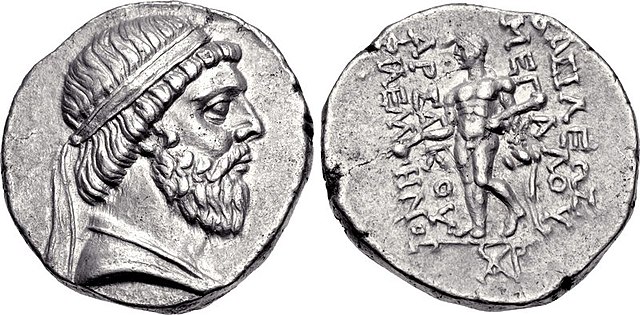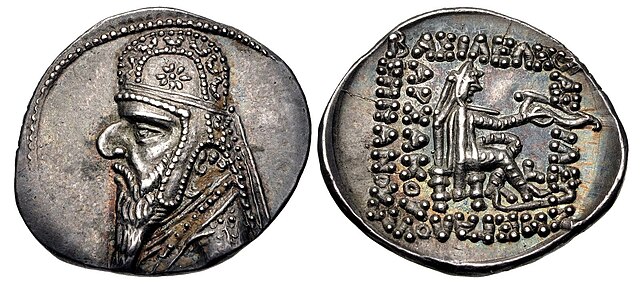Priapatius, was the Arsacid king of Parthia from 191 BC to 176 BC. He was the first-cousin-once-removed and successor of Arsaces II. Like many Arsacid monarchs, his reign is sparsely known. His coinage indicates that he managed to rid himself of the influence of the Seleucid Empire. He was succeeded by his son Phraates I.
Coin of Priapatius, Hekatompylos mint
The Parthian Empire, also known as the Arsacid Empire, was a major Iranian political and cultural power centered in ancient Iran from 247 BC to 224 AD. Its latter name comes from its founder, Arsaces I, who led the Parni tribe in conquering the region of Parthia in Iran's northeast, then a satrapy (province) under Andragoras, who was rebelling against the Seleucid Empire. Mithridates I greatly expanded the empire by seizing Media and Mesopotamia from the Seleucids. At its height, the Parthian Empire stretched from the northern reaches of the Euphrates, in what is now central-eastern Turkey, to present-day Afghanistan and western Pakistan. The empire, located on the Silk Road trade route between the Roman Empire in the Mediterranean Basin and the Han dynasty of China, became a center of trade and commerce.
The silver drachma of Arsaces I (r. c. 247 – 211 BC) with the Greek language inscription ΑΡΣΑΚΟΥ "of Arsaces"
Parthia, shaded yellow, alongside the Seleucid Empire (blue) and the Roman Republic (purple) around 200 BC
Drachma of Mithridates I, showing him wearing a beard and a royal diadem on his head. Reverse side: Heracles/Verethragna, holding a club in his left hand and a cup in his right hand; Greek inscription reading ΒΑΣΙΛΕΩΣ ΜΕΓΑΛΟΥ ΑΡΣΑΚΟΥ ΦΙΛΕΛΛΗΝΟΣ "of the Great King Arsaces the Philhellene"
Drachma of Mithridates II (r. c. 124–91 BC). Reverse side: seated archer carrying a bow; inscription reading "of the King of Kings Arsaces the Renowned/Manifest Philhellene."





